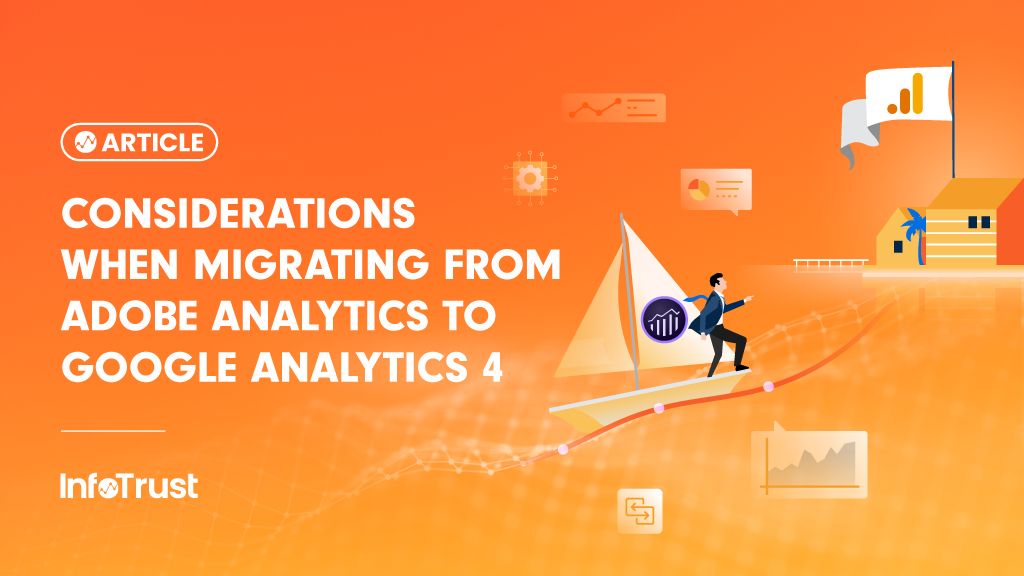Migrating from one analytics platform to another can be compared to moving from one house to another. Just like how you carefully plan and pack your belongings before making a move, it is important to carefully consider all factors before transitioning from Adobe Analytics to Google Analytics 4 (GA4). It requires careful planning, preparation, and execution to ensure a smooth transition and to avoid any potential complications. By keeping a few key considerations in mind, you can ensure that your move to GA4 is successful and that your data continues to provide valuable insights into your business. In this post, we’ll examine the key considerations you need to keep in mind as you move from Adobe Analytics to GA4, including data sampling, manipulation, reporting, and more.
Data Sampling
Data sampling is a common method used to manage the amount of data that is processed, especially when working with large datasets. In digital marketing, data sampling is crucial in helping analysts and marketers make informed decisions about their campaigns.
Adobe Analytics does not perform data sampling by default. This means that all the data that is collected is processed in its entirety. The advantage of this approach is that it provides users with the most accurate representation of their data. However, this also means that processing the data can take longer and can become a bottleneck for the user, especially if they are working with large datasets.
On the other hand, GA4 performs selective sampling by default. This means that the tool only processes a subset of the data that is collected. The advantage of this approach is that it makes data processing faster in the user interface, which is a big advantage for users who are working with large datasets. However, the drawback of this approach is that the data representation may not be 100 percent accurate, and this can lead to incorrect conclusions being drawn from the data.
In GA4, standard reports use aggregated tables, while explorations use raw or user-level tables. This approach allows GA4 to provide faster data processing while still maintaining a high level of accuracy. GA4 360 customers have access to unsampled reports, which provides them with a more accurate representation of their data. GA4 360 users also get access to a feature called “expanded datasets” that can be used to expand the “(other)” row up to 2 million rows of data. Additionally, GA4 users can also connect their data to BigQuery, which is a powerful data warehousing solution that can handle large amounts of data. This allows GA4 users to work with their data in an efficient and scalable manner.
Variable Persistence and Allocation
One of the key features of Adobe Analytics is the ability to track variables, also known as eVars, and allocate credit to these variables based on different criteria. Adobe Analytics eVars can be set to persist across a session or a page, which means that the value of the eVar will continue to be recorded throughout the user’s visit to the website. The persistence of an eVar can also be set to expire after a specific time period, such as a day, week, month, or year. This allows organizations to track important metrics, such as conversions, for a specific time period, and then reset the value of the eVar at the end of that period. In addition to expiring after a specific time period, eVars can also be set to “never expire” provided that the visitorID cookie remains intact. This allows organizations to track metrics, such as repeat visits to the website, over a longer period of time. However, it is important to note that if the visitorID cookie is deleted, the eVar will no longer persist and the value of the eVar will be lost.
In terms of allocation, Adobe Analytics eVars can be allocated credit based on most recent, original value, or linear. The “most recent” allocation method gives credit to the most recent value of the eVar, while the “original value” method gives credit to the first value assigned to the eVar during the session. The linear allocation method distributes credit proportionally between all values assigned to the eVar during the session.
On the other hand, GA4 event parameters have no persistence or expiry, meaning that they are recorded only for the specific event they are tied to. These event parameters can be linked to an event-scoped custom dimension for analysis and reporting within the UI. GA4 also has user properties that can be used to collect user attributes such as user profile, user type, and other user specific metadata. These user properties can be linked to custom dimensions at a user scope. Event-scoped custom dimensions are tied to an event and do not persist, while user-scoped custom dimensions are tied to the user (until the cookie is intact) but this is not retroactive. Additionally, the integration with BigQuery (BQ) also opens the possibility of customizing parameter persistence and credit allocation based on raw data fields such as user_id, user_pseudo_id, session_id, event_timestamp, and other dimensions that are imported to BQ via the GA4 linkage.
In conclusion, both Adobe Analytics and GA4 have different approaches to variable persistence and allocation. Adobe Analytics offers more flexibility in setting the persistence and expiry of eVars, as well as the ability to allocate credit based on different criteria. GA4 event parameters have no persistence or expiry, but user properties can be linked to a user-scoped custom dimension that does have persistence and expiry, at a user level. GA4 -> BQ can also help with defining custom allocation methods and multiple variable persistence methodologies. Although BQ requires more time and dedicated resources to query data, the level of customization it can offer business users is fairly advanced.
Data Manipulation and Reporting
Data analysis is a critical component of modern business operations. It helps organizations make informed decisions and understand their customers, products, and operations better. We will now explore data manipulation and reporting capabilities in Adobe Analytics and GA4 and compare their strengths and weaknesses.
Adobe Analytics is a powerful data analysis tool that allows for heavy data manipulation and reporting. The Analysis Workspace feature in Adobe Analytics provides a flexible and intuitive interface for data analysis. This workspace allows analysts to create segments, calculated metrics, and reports that provide meaningful insights into their data. Segments are custom subsets of data, which can be created based on specific conditions and used in reports, while calculated metrics are custom metrics that can be created and used in reports to measure performance.
On the other hand, GA4 provides custom reports, scorecards, and collections that can be created and published in the UI. The GA4 UI is dynamic, and analysts can expand it by creating custom collections, which may include custom dimensions and metrics as primary dimensions and metrics. GA4’s Explorations feature offers access to raw event and user-level tables, providing analysts with a wealth of data to analyze.
One of the advantages of GA4 over Adobe Analytics is the ability to connect with BQ, which opens up possibilities for advanced analysis, online-offline data stitching, and data modeling. The GA4 and Looker Studio connector is another powerful feature that provides organizations with an integrated platform for data analysis and visualization.
Both Adobe Analytics and GA4 offer powerful data manipulation and reporting capabilities that allow organizations to make informed decisions and better understand their data. However, Adobe Analytics has a more robust data manipulation and reporting capability, while GA4 provides a dynamic UI and the ability to connect with BQ for advanced analysis.
Data Import
Data import is an essential aspect of analytics. Adobe Analytics and GA4 offer various data import methods to enable users to import data from multiple sources. Let’s take a closer look at the different methods of data import in both analytics tools.
In Adobe Analytics, the most common method of data import is through data sources. Users can upload a file to a designated Adobe FTP site, and Adobe retrieves the file and includes the data in the report suite. This method is suitable for importing data from offline sources, such as devices with intermittent internet connectivity, or data from an internal analytics system that makes it infeasible to use client-side Javascript libraries.
Another method of data import in Adobe Analytics is through the Bulk Data Insertion API. This method lets users upload offline/server data in batches of files instead of using client-side libraries. The Bulk Data Insertion API accepts CSV files containing event data, which makes it easier to import large amounts of data into the report suite.
The third method of data import in Adobe Analytics is through the Data Insertion API. This method enables users to programmatically send data points to Adobe via an API. Unlike the Bulk Data Insertion API, the API calls in the Data Insertion API are made one at a time.
Similarly, GA4 offers several data import methods. One method is through UI-based data import, where users can import CSV files using an intuitive user interface. The GA4 UI offers different types of metadata that can be imported, including cost data, item data, user data, and offline events.
Another method of data import in GA4 is through SFTP-based data import. This programmatic approach allows users to upload files to a secure FTP destination and choose the frequency of import. Google automatically picks up the files for import, making it easier to import data from offline sources.
Finally, GA4 also offers the Measurement Protocol, which is similar to the Bulk Data Insertion API in Adobe Analytics. The Measurement Protocol makes it easier to measure interactions that happen server-to-server and offline. While Google does not define the Measurement Protocol as a data import methodology, it is comparable to what Adobe offers through the Bulk Data Insertion API.
Bulk Data Export
Adobe Analytics provides the option of setting up data feeds that can export data on a daily or hourly basis. These automatic data feeds can be configured to send the data in batches to an FTP location, where ETL jobs can be run to structure the data. Additionally, Adobe Analytics also provides an API that can be used to export data in real-time.
GA4, on the other hand, offers a direct integration with BQ, allowing GA4 standard users to export raw data to BQ. This integration provides a convenient and intuitive SQL interface for analyzing the data within BQ, eliminating the need for any ETL processes unless the data needs to be sent to a different data warehouse. GA4 also provides a data API that can be used to access and export data in batches and in real-time.
Both Adobe Analytics and GA4 offer different options for bulk data export, with Adobe Analytics providing a more traditional approach of data feeds and an API, while GA4 provides a direct integration with BQ and a data API for real-time data access. The choice between the two tools will ultimately depend on the specific needs and requirements of the organization.
Conclusion
In conclusion, migrating from Adobe Analytics to GA4 is a significant change that requires careful consideration of several key factors. By understanding the implications of data sampling, variable persistence and allocation, data manipulation and reporting, and data imports and exports, you can ensure a smooth and successful transition. With GA4, you’ll be able to access a wealth of new features and capabilities that can help you gain a deeper understanding of your website and customer behavior. Whether you’re looking to enhance your analytics capabilities or simply want to take advantage of the latest trends in the industry, switching to GA4 is definitely a step in the right direction.


